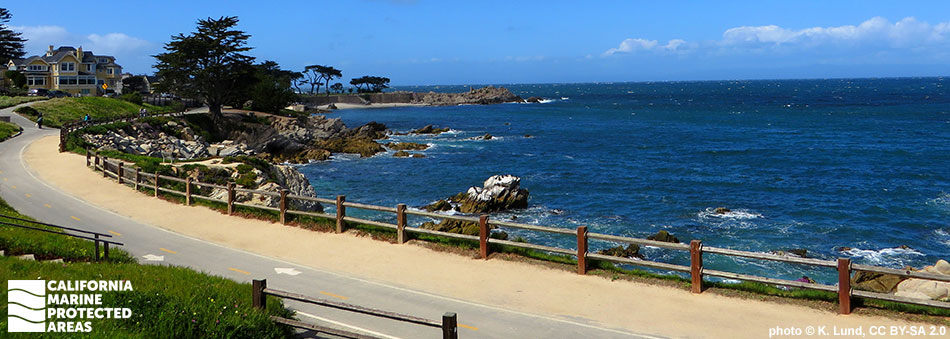
Overview
Lovers Point-Julia Platt State Marine Reserve (SMR) and Edward F. Ricketts State Marine Conservation Area (SMCA) are two of four marine protected areas (MPAs) located on the Monterey Peninsula between Monterey and Pacific Grove. Edward F. Ricketts SMCA is named after the famous 20th century marine biologist who owned a biological supply house on Cannery Row. This nearly quarter square mile MPA stretches along shore for one mile, from the Monterey Coast Guard Jetty to the western edge of the Monterey Bay Aquarium.
The first part of Lovers Point-Julia Platt SMR’s name stems from the headland, Lovers Point, while the second part honors Julia Platt, a marine biologist who became the mayor of Pacific Grove in the 1930s and petitioned the state of California to allow the city to protect its own coastline. Lovers Point-Julia Platt SMR covers just under a half square mile of marine ecosystems off Pacific Grove, which includes a mix of sandy beaches and rocky shoreline, rocky reefs, surfgrass, and kelp forest, with a maximum depth of around 90 feet. The small SMR protects an area that is home to renowned scuba diving, kayaking, surfing, and wildlife viewing. The waters of Edward F. Ricketts SMCA reach about 70 feet deep, and are characterized by sandy beach, rocky shore, surfgrass, and kelp habitats in an area long subjected to human activity.
Surfgrass dominates the shallow subtidal area of both MPAs, offering refuge to a variety of invertebrates such as crabs and shrimp, marine worms and snails, and small fish. Located at the edge of the highly productive waters of Monterey Bay, sea otters forage in both MPAs' thick kelp canopies, while sea lions and harbor seals bask on rocky shores. Other marine mammals like humpback whales, Risso’s dolphins, and elephant seals frequently feed on the abundant krill, crabs, and shrimp. Cabezon and rockfish, along with invertebrates such as limpets, mussels, and abalone, are very common in the kelp canopy and rocky intertidal area. No take is allowed in the SMR, and the only take allowed from the SMCA is recreational take of finfish by hook-and-line and a limited amount of commercial take of giant kelp and bull kelp harvested by hand.
Regulations
Lovers Point-Julia Platt SMR
It is unlawful to injure, damage, take, or possess any living, geological, or cultural marine resource.
California Code of Regulations Title 14, Section 632(b)(76)(opens in new tab)
Edward F. Ricketts SMCA
It is unlawful to injure, damage, take, or possess any living, geological, or cultural marine resource, EXCEPT:
Recreational take of finfish by hook-and-line only is allowed. Commercial take of giant kelp and bull kelp by hand is allowed.
California Code of Regulations Title 14, Section 632(b)(75)(opens in new tab)
Quick Facts
Lovers Point-Julia Platt SMR
MPA size: 0.30 square miles
Shoreline span: 0.9 miles
Depth range: 0 to 88 feet
Habitat composition*:
- Rock: 0.14 square miles
- Sand/mud: 0.38 square miles
Edward F. Ricketts SMCA
MPA size: 0.23 square miles
Shoreline span: 0.7 miles
Depth range: 0 to 74 feet
Habitat composition*:
- Rock: 0.17 square miles
- Sand/mud: 0.16 square miles
*Habitat calculations are based on three-dimensional area and may exceed the total MPA area listed above.